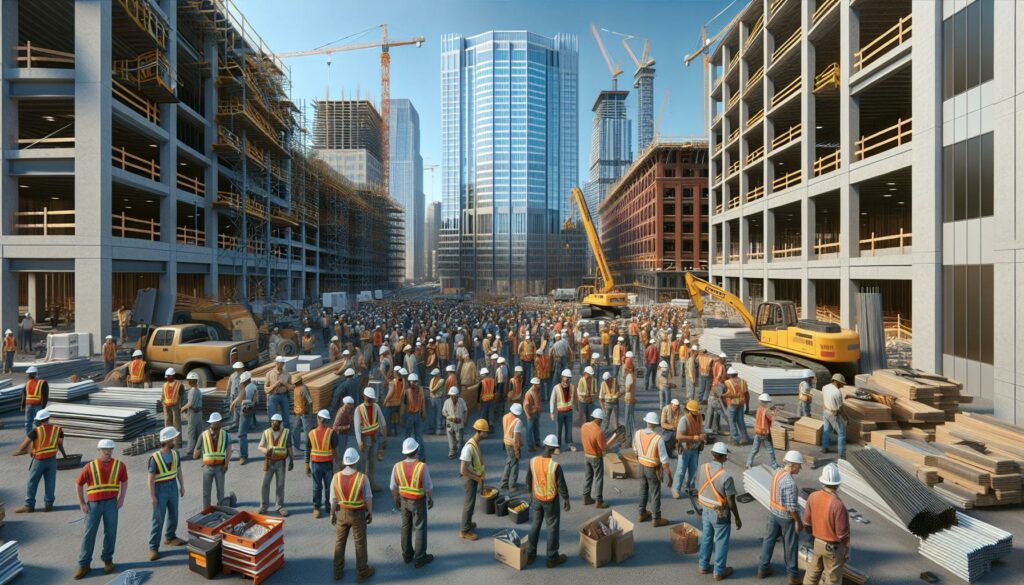As a macroeconomics enthusiast, I’ve noticed that understanding investment in GDP calculations often confuses many students and professionals alike. When we talk about investment for GDP purposes, we’re specifically referring to spending on physical capital goods that help produce future output – not the Wall Street kind of investments you might be thinking of.
I’ll break down how investment in GDP calculations primarily includes three key components: business spending on new equipment and machinery, construction of new structures and buildings, and changes in business inventories. It’s fascinating to see how this definition differs from what most people typically associate with investment, like stocks or bonds. By understanding this distinction, you’ll gain valuable insights into how economists measure a nation’s economic growth and productivity.
Key Takeaways
- Investment in GDP calculations specifically refers to spending on physical capital goods for future production, not financial investments like stocks or bonds.
- The three main components of GDP investment are business fixed investment (machinery and equipment), construction investment (buildings and structures), and changes in business inventories.
- Business fixed investment typically represents 13-15% of GDP, residential construction accounts for 3-5%, and inventory changes range from -0.5% to +0.5%.
- Investment spending directly impacts economic growth through increased production capacity, with automation investments showing 40-60% higher output compared to manual operations.
- GDP investment calculations exclude financial transactions, used equipment purchases, and second-hand asset sales to prevent double-counting and focus on new productive capacity.
For the Purpose of Calculating GDP, Investment is Spending On
Investment in GDP calculations encompasses three primary categories of physical capital expenditure:
- Business Fixed Investment
- Purchase of new machinery
- Installation of manufacturing equipment
- Acquisition of office computers
- Procurement of commercial vehicles
- Construction Investment
- Building new factories
- Developing office complexes
- Creating retail spaces
- Constructing residential housing
- Inventory Investment
- Raw materials stockpiling
- Work-in-progress goods
- Finished products in storage
- Changes in retail inventory levels
| Investment Type | Percentage of GDP (US Average) |
|---|---|
| Business Fixed | 13.5% |
| Construction | 6.8% |
| Inventory | 0.5% |
Financial transactions like buying stocks, bonds or mutual funds don’t count in GDP investment calculations. The focus remains on tangible assets that directly contribute to production capacity. I measure investment based on the purchase price of new capital goods during the accounting period, excluding depreciation or second-hand purchases.
Inventory investment captures the net change in business stockpiles. A positive inventory investment indicates businesses have increased their stocks, while negative values show a reduction in inventory levels. These changes provide insights into business expectations and economic conditions.
The measurement includes both domestic and imported capital goods, tracking the total spending on productive assets regardless of origin. This comprehensive approach ensures GDP accurately reflects the economy’s investment in future productive capacity.
Components of Investment Spending
Investment spending in GDP calculations encompasses three distinct categories that directly contribute to an economy’s productive capacity.
Business Fixed Investment
Business fixed investment represents spending on capital goods like machinery, equipment, and commercial structures used in production processes. Manufacturing companies invest in assembly line robots, retailers purchase point-of-sale systems, and service firms acquire office computers. Data shows business fixed investment typically constitutes 13-15% of total GDP in developed economies.
Residential Construction
Residential construction includes expenditures on new housing units and major renovations to existing homes. This category captures spending on single-family homes, apartment buildings, condominiums and housing developments. The residential construction component averages 3-5% of GDP, fluctuating with housing market cycles and interest rates.
Changes in Business Inventories
Changes in business inventories measure the net change in the physical quantity of goods held by businesses for future sale. A manufacturer increasing its stock of raw materials, a retailer expanding its product selection, or a wholesaler building up finished goods inventory all contribute to this component. Inventory changes commonly range from -0.5% to +0.5% of GDP, serving as an indicator of business confidence and economic conditions.
| Investment Component | Typical % of GDP |
|---|---|
| Business Fixed | 13-15% |
| Residential Construction | 3-5% |
| Inventory Changes | -0.5% to +0.5% |
Capital Goods and Equipment Purchases
Capital goods and equipment purchases represent the physical assets businesses acquire to produce goods or provide services. These investments directly contribute to increasing productive capacity and economic output.
Manufacturing Equipment and Machinery
Manufacturing equipment investments encompass production line machinery, robotic systems and automated manufacturing tools. Major categories include:
- Industrial robots for assembly lines ($25,000-$400,000 per unit)
- CNC machines for precision manufacturing ($50,000-$500,000 per system)
- Material handling equipment like forklifts ($20,000-$100,000 per vehicle)
- Quality control and testing equipment ($10,000-$250,000 per setup)
| Equipment Type | Average Investment Range | Typical Lifespan |
|---|---|---|
| Industrial Robots | $25,000-$400,000 | 12-15 years |
| CNC Machines | $50,000-$500,000 | 15-20 years |
| Forklifts | $20,000-$100,000 | 8-10 years |
| Testing Equipment | $10,000-$250,000 | 5-8 years |
- Factory buildings ($150-$250 per square foot)
- Warehouses ($50-$150 per square foot)
- Office complexes ($200-$400 per square foot)
- Production facilities ($180-$300 per square foot)
| Structure Type | Cost per Square Foot | Average Size Range |
|---|---|---|
| Factories | $150-$250 | 50,000-200,000 sq ft |
| Warehouses | $50-$150 | 20,000-100,000 sq ft |
| Offices | $200-$400 | 10,000-50,000 sq ft |
| Production Facilities | $180-$300 | 30,000-150,000 sq ft |
Relationship Between Investment and Economic Growth
Investment spending directly influences economic growth by expanding production capabilities and creating new employment opportunities. This relationship manifests through multiple channels that affect both short-term economic activity and long-term growth potential.
Impact on Productive Capacity
Investment in capital goods expands an economy’s production frontier by increasing output capacity per worker. Manufacturing plants equipped with automated assembly lines produce 40-60% more units per hour compared to manual assembly operations. Fixed investments in advanced machinery, such as robotic welding systems ($150,000-$300,000 per unit), enable companies to manufacture products with greater precision and efficiency. Companies that invest 15-20% of their revenue in new equipment experience an average productivity increase of 25% over five years.
- Equipment Orders: A 10% increase in capital goods orders leads to a 2-3% rise in manufacturing employment
- Construction Projects: New commercial construction drives 4-5 additional jobs per $1 million invested
- Inventory Accumulation: A 1% rise in inventory investment correlates with a 0.3% increase in GDP growth
| Investment Indicator | Impact on Economic Activity |
|---|---|
| Equipment Orders | +2-3% manufacturing jobs per 10% increase |
| Construction Projects | 4-5 jobs per $1M invested |
| Inventory Changes | 0.3% GDP growth per 1% increase |
Exclusions from GDP Investment Calculations
GDP investment calculations exclude several types of transactions to prevent double-counting and maintain focus on new productive capacity in the economy. These exclusions help maintain accuracy in measuring actual economic growth and production capacity.
Financial Assets and Securities
The purchase of stocks, bonds, mutual funds, derivatives or other financial instruments doesn’t count for the purpose of calculating GPD, investment is spending on. Trading $100,000 in company shares or buying $50,000 in government bonds represents a transfer of existing assets rather than new production. Financial transactions include:
- Stock market purchases on exchanges like NYSE or NASDAQ
- Corporate or government bond acquisitions
- Cryptocurrency investments or digital asset trades
- Purchase of certificates of deposit or money market funds
- Derivatives contracts like futures or options
- Used machinery or equipment sales between businesses
- Previously owned vehicles or transportation equipment
- Existing building purchases without renovations
- Second-hand computer systems or office furniture
- Used manufacturing equipment transfers
| Type of Excluded Transaction | Reason for Exclusion |
|---|---|
| Financial Assets | Transfer of existing wealth |
| Used Equipment | No new production created |
| Stock Trading | Paper transaction only |
| Second-hand Buildings | Previously counted in original construction |
| Used Vehicle Sales | Already included in initial purchase |
GDP calculation
I’ve shown for the purpose of calculating GDP, investment is spending on encompasses three key areas: business fixed investment spending on equipment and machinery construction investment in new structures and changes in business inventories. These components directly impact our economy’s productive capacity and future growth potential.
Understanding what counts as investment for GDP purposes helps us better analyze economic trends and make informed decisions. The focus on physical capital formation rather than financial transactions ensures we’re measuring real economic expansion.
As businesses continue investing in new equipment modern facilities and inventory management they’re not just spending money – they’re building the foundation for tomorrow’s economic growth and productivity gains.

